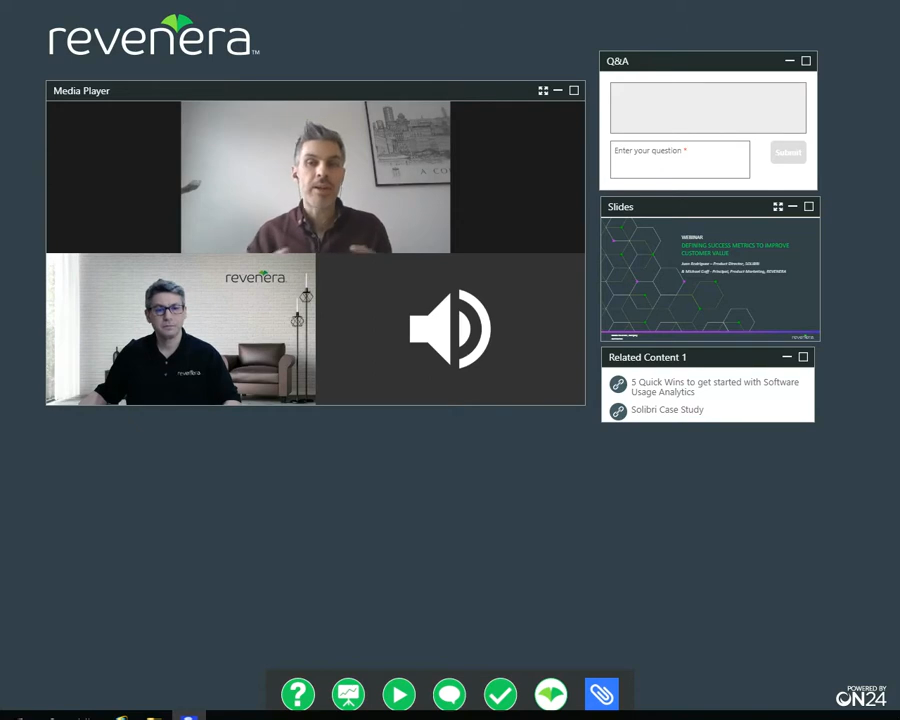Webinar
Defining Success Metrics to Improve Software Customer Value
Discover how Solibri uses data-driven success metrics to boost user engagement, retention, and product value in the BIM software space.
Original Air Date: March, 2021
Overview
If you're a software producer looking to unlock deeper customer value and drive product success, this webinar is a must-watch. Join Michael Goff, Principal Product Marketing at Revenera, and Juan Rodriguez, Product Director at Solibri, as they dive into how Solibri—an industry leader in model checking software for BIM—uses data-driven success metrics to shape product strategy and improve user engagement. In just 30 minutes, you'll learn how Solibri defines and tracks success metrics beyond traditional KPIs, and how those insights fuel smarter development decisions and better customer outcomes.
Discover how usage analytics can reveal surprising patterns, like feature adoption gaps or platform preferences, and how Solibri leverages those insights to refine onboarding, boost retention, and guide in-product education. You'll also hear how their internal dashboards connect product usage to business performance, helping leadership teams make informed decisions faster. Whether you're building SaaS or on-prem software, this session will show you how to turn data into actionable product intelligence. Don’t miss the chance to learn from a team that’s transforming customer feedback and analytics into measurable success.
Recap
Key Themes and Takeaways
Solibri’s Mission in the BIM Space
Juan Rodriguez</Product Director> opened with an overview of Solibri, emphasizing its role in providing quality assurance tools for construction projects. Their software analyzes 3D models to ensure compliance with project requirements, helping teams navigate the complexity of multi-stakeholder construction environments.
Becoming a Data-Driven Organization
Since 2017, Solibri has focused on becoming more data-driven. They collect user interaction data to understand behavior patterns, such as frequency of use and feature engagement. This shift has allowed them to better define user personas and tailor product development to actual usage.
Defining Success Metrics vs. KPIs
Rodriguez distinguished between success metrics and KPIs. Success metrics help evaluate whether a new feature delivers value to users, while KPIs are broader business goals like maintaining a consistent number of monthly active users. This distinction helps Solibri align product decisions with both user needs and business outcomes.
Using Pirate Metrics to Guide Strategy
Solibri applies Dave McClure’s “Pirate Metrics” framework—acquisition, activation, retention, referral, and revenue—to track the customer journey. While some metrics like referral are still being developed, others like activation and retention are actively monitored to improve trial conversions and long-term engagement.
In-Product Education and Onboarding
To improve ease of use and trial conversion, Solibri is implementing in-product tutorials and guided experiences. These help users navigate complex workflows and adopt best practices, especially in a mature, on-premises product environment.
Balancing Quantitative and Qualitative Insights
Solibri combines usage analytics with direct user feedback to validate product decisions. For example, they identified a drop-off in how users communicated design issues and redesigned a feature to improve that workflow—resulting in a measurable increase in usage.
Building a Company-Wide Dashboard
A 30-day snapshot dashboard was created to unify data from CRM, support, and product usage. This tool helps leadership understand performance across acquisition, retention, and revenue, and has sparked new questions and insights that guide strategic decisions.
Surprising Discoveries from Usage Analytics
One unexpected insight was that only about 5% of Solibri’s users were on Mac, despite assumptions about architects preferring Apple devices. Another was the disparity in usage across different model checks—some being used hundreds of times per session, others only once—highlighting the need to contextualize data before drawing conclusions.
Enabling Smarter Experimentation
With robust analytics in place, Solibri can now experiment more confidently. Data helps them prioritize development efforts, validate assumptions, and iterate faster, making their product planning more efficient and customer-centric.
Speakers

Juan Rodriguez
Product Director
Solibri

Michael Goff
Principal Product Marketer
Revenera
Frequently Asked Questions
Success metrics are specific indicators used to evaluate whether a new feature or product delivers value to users. Unlike general KPIs, success metrics focus on user behavior, feature adoption, and engagement patterns. Tracking these metrics helps software teams validate development decisions and improve customer satisfaction. They are essential for aligning product outcomes with user needs.
Usage analytics provide insights into how users interact with a product, including which features are used most and where drop-offs occur. By analyzing this data, software companies can identify friction points and optimize workflows to keep users engaged. Retention improves when users consistently find value in the product experience. Monthly active user tracking is a common retention metric.
KPIs (Key Performance Indicators) are high-level business goals, such as revenue growth or user acquisition targets. Success metrics, on the other hand, are more granular and tied to specific product features or user behaviors. Understanding both helps software producers balance strategic business outcomes with tactical product improvements.
In-product tutorials guide users through key workflows, reducing the learning curve and increasing the likelihood of successful onboarding. This leads to higher trial-to-paid conversion rates, especially for complex or mature software products. Tutorials also help users discover valuable features they might otherwise overlook.
Tracking feature-level engagement helps teams understand which parts of the product deliver the most value. It reveals underused features that may need redesign or better promotion. This data-driven approach ensures development resources are focused on what matters most to users and drives better ROI.
Dashboards that combine CRM, support, and usage data offer a unified view of product performance. They help leadership teams monitor acquisition, retention, and revenue trends in real time. This visibility enables faster decision-making and ensures product strategies are aligned with business objectives.
Pirate Metrics—Acquisition, Activation, Retention, Referral, and Revenue—are a framework for tracking the customer journey. Software producers use these metrics to understand how users discover, engage with, and continue using their products. Applying this model helps optimize each stage of the funnel for better monetization outcomes.
Segmenting users by behavior, geography, or platform helps software teams tailor experiences and messaging. For example, identifying expert vs. novice users allows for targeted onboarding and feature promotion. Segmentation also reveals usage trends that inform roadmap decisions and marketing strategies.
While analytics provide quantitative insights, qualitative feedback from users adds context and depth. It helps validate assumptions and uncover pain points that data alone might miss. Combining both types of input leads to more informed and user-centric product decisions.
With robust usage data, software teams can test hypotheses, measure outcomes, and iterate quickly. Analytics reduce guesswork and highlight what’s working or not. This enables more confident experimentation, faster learning cycles, and ultimately better product-market fit.
Resources
Case Study
a.i. solutions® Launch Flexible Licensing to Accelerate Growth
See how they saved two years in development time, reduced support tickets by 500%, and continue to grow.
Industry Report
Forrester Total Economic Impact Study
Learn More About 426% ROI and Operational Efficiencies Enabled by Revenera
Case Study
Toon Boom Drives Double-Digit Growth with Streamlined Monetization Processes
The implementation of the new licensing and entitlement management solution resulted in several tangible benefits for Toon Boom.
Want to learn more?
See how Revenera's Software Monetization platform can help you take products to market fast, unlock the value of your IP and accelerate revenue growth.
